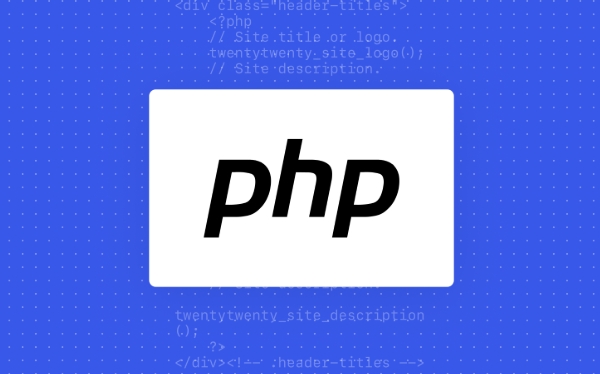 Backend Development
Backend Development
 PHP Tutorial
PHP Tutorial
 Optimizing Conditionals by Encapsulating Logic in Boolean Functions
Optimizing Conditionals by Encapsulating Logic in Boolean Functions
Optimizing Conditionals by Encapsulating Logic in Boolean Functions
Jul 30, 2025 am 02:16 AMEncapsulate complex or repeated conditional logic into boolean functions to improve readability, maintainability, and testability. 2. Use intent-revealing function names like can_user_access_service() to clarify the purpose of the condition. 3. Centralize shared logic to eliminate duplication and ensure changes only require updates in one place. 4. Write unit tests for boolean functions to validate edge cases in isolation. 5. Apply this pattern when conditions are lengthy, repeated, unclear, or accompanied by explanatory comments, choosing names that reflect business rules such as should_send_reminder() or is_order_refundable(). 6. If an if statement requires significant thought to understand, extract it into a well-named boolean function.

When code is littered with complex conditional expressions—especially repeated ones—readability and maintainability suffer. A powerful technique to clean this up is encapsulating conditional logic in boolean functions. Instead of writing long if statements with multiple conditions, you extract the logic into well-named functions that return true or false. This not only improves clarity but also makes your code more modular and testable.

Improve Readability with Intent-Revealing Names
A boolean function with a descriptive name explains why a condition exists, not just what it does.
For example, instead of:

if user.is_active and not user.subscription_expired and user.remaining_credits > 0:
grant_access()You can write:
if can_user_access_service(user):
grant_access()
def can_user_access_service(user):
return user.is_active and not user.subscription_expired and user.remaining_credits > 0Now, the condition's intent is clear just by reading the function name. Anyone reading the code doesn’t need to reverse-engineer the logic to understand what’s being checked.

Reduce Duplication and Improve Maintainability
If the same condition appears in multiple places, duplicating the expression is risky. A change in business logic means you have to update it everywhere—which is error-prone.
By wrapping the logic in a function, you centralize the rule:
def is_high_risk_transaction(transaction):
return (transaction.amount > 10000 or
transaction.country in HIGH_RISK_COUNTRIES or
transaction.is_suspicious_pattern())Now, every place that needs to check risk uses is_high_risk_transaction(transaction). If the threshold changes, you only update it once.
Make Testing Easier
Boolean functions are easy to unit test in isolation. You can write clear test cases for all edge conditions without needing to exercise larger, more complex workflows.
def test_can_user_access_service():
active_user = User(is_active=True, subscription_expired=False, remaining_credits=5)
assert can_user_access_service(active_user) is True
expired_user = User(is_active=True, subscription_expired=True, remaining_credits=5)
assert can_user_access_service(expired_user) is FalseThis leads to more reliable code and faster debugging.
When to Apply This Pattern
You should consider extracting a boolean function when:
- A condition spans multiple lines or uses several logical operators (
and,or,not) - The same condition appears in more than one place
- The meaning of the condition isn’t immediately obvious
- You find yourself writing comments to explain why a condition exists
In such cases, ask: "What is this condition really checking?" Then name the function accordingly—should_send_reminder(), is_order_refundable(), has_reached_limit().
Final Thoughts
Encapsulating conditionals in boolean functions is a small change that pays big dividends. It turns cryptic logic into readable, reusable, and testable code. The key is choosing clear, behavior-focused names that reflect business rules, not just technical conditions.
Basically: if your if statement makes you pause and think, it’s probably time to extract a function.
The above is the detailed content of Optimizing Conditionals by Encapsulating Logic in Boolean Functions. For more information, please follow other related articles on the PHP Chinese website!

Hot AI Tools

Undress AI Tool
Undress images for free

Undresser.AI Undress
AI-powered app for creating realistic nude photos

AI Clothes Remover
Online AI tool for removing clothes from photos.

Clothoff.io
AI clothes remover

Video Face Swap
Swap faces in any video effortlessly with our completely free AI face swap tool!

Hot Article

Hot Tools

Notepad++7.3.1
Easy-to-use and free code editor

SublimeText3 Chinese version
Chinese version, very easy to use

Zend Studio 13.0.1
Powerful PHP integrated development environment

Dreamweaver CS6
Visual web development tools

SublimeText3 Mac version
God-level code editing software (SublimeText3)
 Harnessing Short-Circuit Evaluation in PHP's Logical Operators
Jul 29, 2025 am 05:00 AM
Harnessing Short-Circuit Evaluation in PHP's Logical Operators
Jul 29, 2025 am 05:00 AM
Short circuit evaluation is an important feature of logic operators in PHP, which can improve performance and avoid errors. 1. When using &&, if the left operand is false, the right operand will no longer be evaluated; 2. When using ||, if the left operand is true, the right operand will be skipped; 3. It can be used to safely call object methods, such as if($user&&$user->hasPermission('edit')) to avoid empty object calls; 4. It can optimize performance, such as skipping expensive function calls; 5. It can provide default values, but please note that || is sensitive to falsy values, and you can use the ?? operator instead; 6. Avoid placing side effects on the right side that may be skipped to ensure that key operations are not short-circuited. just
 Improving Code Readability with Guard Clauses and Early Returns
Jul 29, 2025 am 03:55 AM
Improving Code Readability with Guard Clauses and Early Returns
Jul 29, 2025 am 03:55 AM
Using guard clauses and early return can significantly improve code readability and maintainability. 1. The guard clause is a conditional judgment to check invalid input or boundary conditions at the beginning of the function, and quickly exit through early return. 2. They reduce nesting levels, flatten and linearize the code, and avoid the "pyramid bad luck". 3. Advantages include: reducing nesting depth, expressing intentions clearly, reducing else branches, and facilitating testing. 4. Commonly used in scenarios such as input verification, null value check, permission control, and empty collection processing. 5. The best practice is to arrange the checks in order from basic to specific, focusing on the function start part. 6. Avoid overuse in long functions causing process confusion or causing resource leakage in languages that require resource cleaning. 7. The core principle is: check as soon as possible and return as soon as possible
 Mastering Strict vs. Loose Comparisons in PHP Conditionals
Jul 29, 2025 am 03:05 AM
Mastering Strict vs. Loose Comparisons in PHP Conditionals
Jul 29, 2025 am 03:05 AM
Using == for strict comparison will check the value and type at the same time, and == will perform type conversion before comparing the value; therefore 0=='hello' is true (because 'hello' is converted to an integer is 0), but 0==='hello' is false (different types); common traps include '0'==false, 1=='1abc', null==0 and []==false are all true; it is recommended to use === by default, especially when processing function return value (such as strpos), input verification (such as the third parameter of in_array is true), and state judgment to avoid unexpected results caused by type conversion; == is only used when it is clearly necessary to use ==, otherwise
 Refactoring the Pyramid of Doom: Strategies for Cleaner PHP if Blocks
Jul 29, 2025 am 04:54 AM
Refactoring the Pyramid of Doom: Strategies for Cleaner PHP if Blocks
Jul 29, 2025 am 04:54 AM
Useearlyreturnstohandlepreconditionsandeliminatedeepnestingbyexitingfastonfailurecases.2.Validateallconditionsupfrontusingadedicatedhelpermethodtokeepthemainlogiccleanandtestable.3.Centralizevalidationwithexceptionsandtry/catchblockstomaintainaflat,l
 Implementing Dynamic Feature Flags with Elegant Conditional Logic
Jul 29, 2025 am 03:44 AM
Implementing Dynamic Feature Flags with Elegant Conditional Logic
Jul 29, 2025 am 03:44 AM
Maintainable implementations of dynamic functional flags rely on structured, reusable, and context-aware logic. 1. Structural definition of function flags as first-class citizens, centrally manage and accompany metadata and activation conditions; 2. Dynamic evaluation is performed based on runtime context (such as user roles, environments, grayscale ratios) to improve flexibility; 3. Abstract reusable condition judgment functions, such as roles, environments, tenant matching and grayscale release, avoiding duplicate logic; 4. Optionally load flag configurations from external storage, supporting no restart changes; 5. Decouple flag checks from business logic through encapsulation or hooks to keep the code clear. Ultimately achieve the goals of secure release, clear code, fast experimentation and flexible runtime control.
 Secure by Design: Using if Statements for Robust Input Validation
Jul 30, 2025 am 05:40 AM
Secure by Design: Using if Statements for Robust Input Validation
Jul 30, 2025 am 05:40 AM
InputvalidationusingifstatementsisafundamentalpracticeinSecurebyDesignsoftwaredevelopment.2.Validatingearlyandoftenwithifstatementsrejectsuntrustedormalformeddataatentrypoints,reducingattacksurfaceandpreventinginjectionattacks,bufferoverflows,andunau
 Performance Deep Dive: if-elseif-else vs. switch in Modern PHP
Jul 29, 2025 am 03:01 AM
Performance Deep Dive: if-elseif-else vs. switch in Modern PHP
Jul 29, 2025 am 03:01 AM
Switch is usually faster than if-elseif-else, especially when there are more than 5 discrete values and PHP can be optimized to skip tables; 2. If-elseif is more suitable for complex or range condition judgments; 3. The performance of the two is similar when a small number of conditions (1–3); 4. Turn on Opcache to improve the optimization opportunities of switches; 5. Code readability is preferred, and it is recommended to use PHP8.0 match expressions in simple mapping scenarios because they are simpler and have better performance.
 Optimizing Conditionals by Encapsulating Logic in Boolean Functions
Jul 30, 2025 am 02:16 AM
Optimizing Conditionals by Encapsulating Logic in Boolean Functions
Jul 30, 2025 am 02:16 AM
Encapsulatecomplexorrepeatedconditionallogicintobooleanfunctionstoimprovereadability,maintainability,andtestability.2.Useintent-revealingfunctionnameslikecan_user_access_service()toclarifythepurposeofthecondition.3.Centralizesharedlogictoeliminatedup





